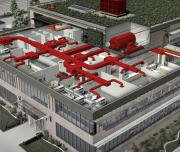System Impacts
Financial Impact
When employing sustainable HVAC strategies, financial benefits can be realized from several sources, including energy savings from proper controls, efficient equipment and behavioral change, as well as increased productivity and reduced maintenance costs.
For a high-level overview, watch DOE Better Buildings' The Business Case for High-Performance Buildings.
Findings and Case Studies
Finding: Top finishers in the 2011 National Building Competition saved as much as 63% and as much as $505,000 in a single year. That’s not $505,000 cumulatively, that’s for just one building among many big savers! Source: 2011 National Building Competition Wrap-Up Report
Finding: A 30 percent reduction in energy consumption can lower operating costs by $25,000 per year for every 50,000 square feet of office space.Source: Flex Your Power, Best Practice Guide: Commercial Office Buildings
Did You Know?
Source: NREL, Implementing Water Conservation Goals at Federal Facilities - Lessons Learned
Federal facilities use sixty billion Btu of energy annually to process, heat, and distribute water throughout the building. Source: Water Conservation - WBDG

